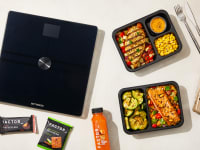This handheld vacuum sealer could save you hundreds on groceries
We tested the Zwilling Fresh & Save on storage, sous vide and more.
Products are chosen independently by our editors. Purchases made through our links may earn us a commission.
Ever since the start of the pandemic, we’ve been trying to help our readers stretch their grocery hauls with pantry meal ideas, new kitchen techniques, and even longlasting grocery tricks. And even if most of us might feel more comfortable venturing out to grocery stores now, new challenges—like supply chain disruptions and record-breaking inflation—have forced us to maintain some of these stingy habits two years later. From regrowing alliums in water to rewrapping meat and herbs, there are a lot of tips and tricks we can all follow to stretch out food between grocery trips—but there are also devices that claim to make the process even easier.
Knife brand Zwilling's Fresh & Save system is a handheld vacuum sealer that works with compatible plastic bags and glass containers to keep food fresh, longer. While we’re no stranger to vacuum sealers here at Reviewed, we’ve never used anything quite like Zwilling’s Fresh and Save—so we decided to give it a run through our kitchen to see if it’s worth the investment.
What’s in the Zwilling Fresh & Save system?
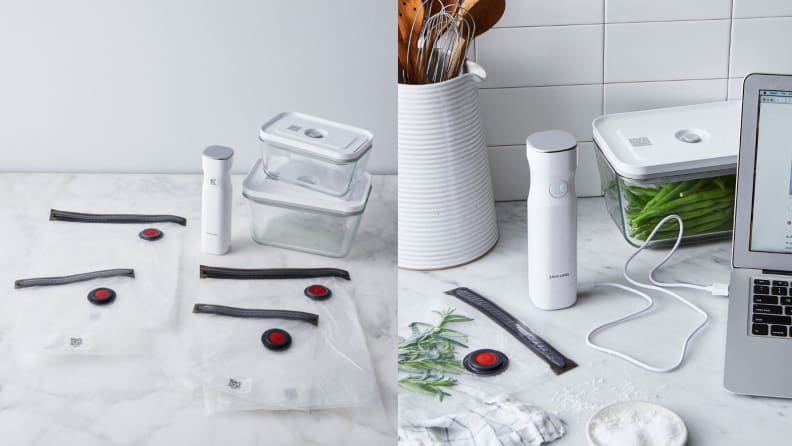
The starter set comes with the vacuum pump, two glass containers, and four vacuum bags.
The central Fresh & Save starter set (available for $99) contains one medium borosilicate glass container, one larger glass container, two small vacuum-seal bags, two medium bags, and one vacuum pump, as well as a charging system for the pump.
Unlike most tabletop vacuum sealers we’ve used that cut and seal plastic bags to your desired length, the Zwilling device is a modest handheld pump that looks more like an immersion circulator. This makes it extremely easy to use and store, but also means it’s only compatible with containers and bags from the Fresh & Save system.
Once the pump is charged, you just remove the cap, position it on the seal of one of the bags or containers, and then press the button until the sealing is complete and the pump turns off.
The bags can be reused and hand-washed if used for dry ingredients like bread, snacks, and vegetables, but are recommended as one-use for storing or cooking raw meat, cheese, and eggs. The glass containers are dishwasher- and microwave-safe. You can also separately purchase an additional set of 10 bags for $15, and an additional large glass container for $30.
How does the Zwilling Fresh & Save work?
To see how the Zwilling Fresh & Save system stacks up against regular storage methods, I used it to store fruits and greens, freeze meat and leftovers, and sous vide pork chops in my home kitchen for two weeks. Here’s the breakdown of how it performed in each category.
Fridge storage
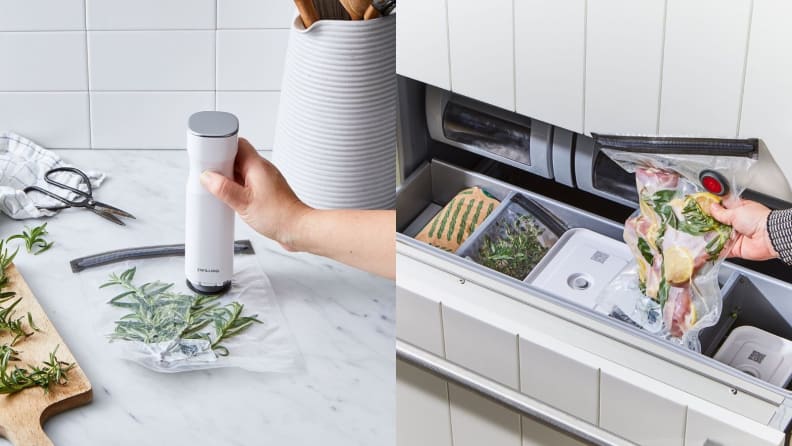
The vacuum sealer is designed to keep foods fresh in the fridge and freezer.
The most common application of the Fresh & Save system for most households is regular fridge storage. Both the bags and glass containers can be used to store fruits, vegetables, leftovers, cooked eggs, herbs, and more for anywhere from a few days to a few weeks.
Although my fridge is typically full of dinner leftovers, those get eaten quickly, so I wanted to focus testing on foods that tend to spoil or smell—herbs, berries, greens, and hard-boiled eggs. I used the smaller vacuum seal bags to store cilantro and arugula, and the medium storage containers to store strawberries and hard-boiled eggs.
The sealing itself was very straightforward—I just placed the pump over each seal, pressed the button, and waited until the air was fully gone. Although I later ran into issues getting a tight seal with the sous vide bags, I didn’t have that issue with either the arugula or the cilantro, probably because greens are less bulky and produce zero liquid, unlike meat.
Ultimately, I was extremely pleased with the results for fridge storage. The arugula and cilantro stayed green and mostly springy in their bags for a full two weeks, with minimal wilting and zero green slime compared to my usual storage in regular plastic bags. I noticed the seal did get “weaker” over time in the fridge on the arugula bag, so I refreshed it and re-sealed it about a week later.
Strawberries also stayed bright and mostly plump for the two weeks, and the hard-boiled eggs didn’t produce any off smells in the fridge (those, I will note, were only left in their container for about a week).
My one complaint? Because I live in a household of five that cooks and eats a lot, there aren’t many ingredients that are sitting untouched in my fridge for weeks on end. That means we had to regularly break the vacuum and re-seal the bags to get ingredients and snacks out each day. If you’re committed to making a giant pack of arugula last for two weeks, the Fresh & Save system is a huge help—but you’ll need to spend more time than usual preserving your food.
Freezer storage
My partner was smart enough to invest in a chest freezer before quarantine began, so we’ve been freezing more meat, leftovers, and bread than ever. I’m typically happy with both this chest freezer and our standard freezer, but the occasional frostburn does pop up on things we’ve let sit too long or not sealed correctly.
To see if the Fresh & Save could help, I sealed some roast beef (cooked and sliced at home) and leftover coq au vin into the larger plastic bag and glass container, respectively, and put them in the freezer. I also put some of the leftovers in standard glass containers and bags with no vacuum seal so I could compare the results.
After two weeks, the two containers of coq au vin looked roughly the same—frozen solid, with no traces of freezer burn. But the roast beef sealed with the Fresh & Save looked much better than the one simply placed in a freezer bag. It looked just as it did the day I sliced it, whereas the meat in the standard freezer bag had some freezer burn beginning to form.
Everything I froze using the Fresh & Save and the standard containers and bags was still perfectly edible, but after a few more weeks in the freezer, I’m sure I’d much prefer to eat the food that was vacuum sealed.
One thing that prevents me from recommending the Fresh & Save for all frozen leftovers is the fact that you’re not supposed to vacuum seal any liquids. I often want to save soups, stews, and curries, but Zwilling recommends pre-freezing those foods before vacuum sealing, which makes this a longer and more involved process.
You also can’t vacuum seal ingredients that are any hotter than room temperature, so you’ll need to wait to let everything cool completely before sealing and freezing them.
Sous vide
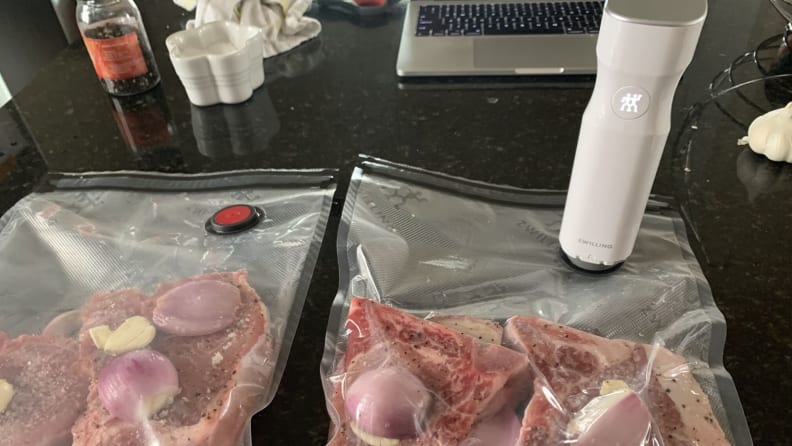
The vacuum bags weren't as easy to seal on the pork chops as they were on dry ingredients.
As I’m part of a household that loves our immersion circulator, I was most curious about how the Fresh & Save would help my sous vide game. Although I used vacuum sealers in our official testing of immersion circulators, at home I tend to just use the displacement method and standard freezer bags to seal up meat and vegetables. I can’t be bothered to break out a big vacuum sealer just to cook dinner.
I prepped four bone-in pork chops the way I usually would (with salt, pepper, garlic, and herbs) and placed them in the two larger vacuum seal bags. The manual recommends keeping food away from the seal, so I made sure the chops were as far down in the bag as possible, and I tried to create a small fold above the chops to prevent the residual liquid from getting sucked into the vacuum sealer.
The first bag went off without a hitch—after I pressed the button, the bag was sealed with pork chops in about 10 seconds. Unfortunately, when I went to seal the second bag, some of the liquid crept through the seal and into the pump. Per the manual’s instructions, I turned the pump off, cleaned the seal, and tried to readjust the bag so no liquid would get in again. I was ultimately able to seal the bag, but the seal wasn’t very tight—I also noticed some air had crept back into the first bag, so I tried to seal it again before placing the bags in the water bath.
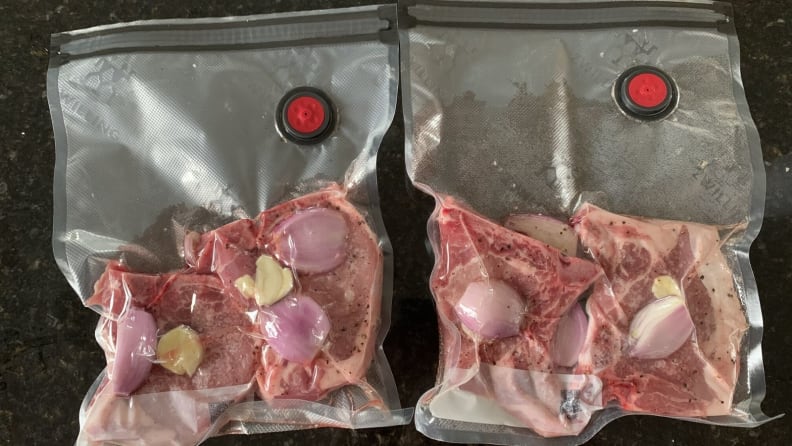
A bit of liquid creeped toward the vacuum seal on one of the bags (see right).
After two hours in the water bath with our Anova immersion circulator, the chops came out tender and well-cooked as always—and I didn’t notice any water leakage into the bags. The vacuum seal might not have been perfect, but that didn’t affect the outcome of my dinner.
My disappointment only came when it was time for clean-up. Typically, I’d just toss out the plastic freezer bags I used for sous vide when I’m done—not great for the environment, but not costly. I thought I would be able to save and reuse the Zwilling bags for sous vide, but per the manual’s instructions, any bags used to cook raw meat shouldn’t be reused. And unlike freezer bags that are fairly thin and inexpensive, each Zwilling bag costs about $1.50 on its own, and has a specialized seal that seems anything but biodegradable.
As I didn’t see an improvement in my cooked food from using the Zwilling and the bags aren’t reusable, I can’t justify consistently using the Fresh & Save system for sous vide. Some users note in their reviews of the product that they reuse certain bags for sous vide despite Zwilling’s advice, so if you’re willing to do that, the cost might be worth it—but as is, I can’t recommend it.
What users have to say
The Zwilling Fresh & Save starter set is well-rated on both the Zwilling website (where it has 4.8 out of 5 stars and over 8,000 reviews) and Food52 (where it has 4 out of 5 stars and 45 reviews). Users note how the system has helped them with meal-prepping and reducing food waste, and how easy it is to use and store the pump.
Some negative reviews point to the glass containers chipping and the bags not holding a strong seal. Earlier negative reviews complain about the lack of extra bags available, but those bags are now sold separately.
Is the Zwilling Fresh & Save worth the investment?
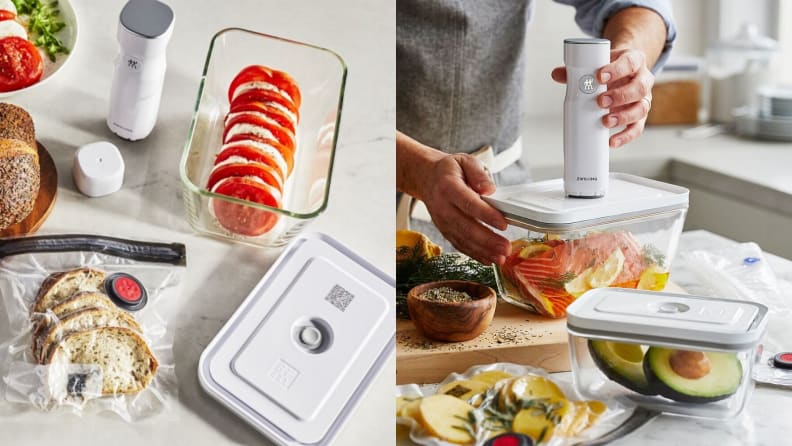
The Zwilling Fresh & Save is a great food storage solution.
If you’re willing to spend a little over $100 just for food storage, the Zwilling Fresh & Save system is a great option to help reduce food waste and make your groceries last longer. I was very impressed by how it was to use the pump and how well it preserved both fresh and frozen foods, particularly greens and herbs.
I wouldn’t recommend the Fresh & Save for sous vide alone, however. The bags never leaked and my food turned out great, but they weren’t much better than standard freezer bags—and they’re not reusable with raw meat. For the price, you’d be better off with a standard vacuum sealer or the displacement method.
But if storage is your number one concern, the Fresh & Save is a sleek, easy-to-use system that will surely save you some cash in the long run.
Get the Zwilling Fresh & Save Starter Set at Zwilling for $99
You’re on your way to becoming a kitchen master. Take the next step and sign up for Chef's Course. You’ll get weekly tips, tricks, and recipes from top chefs sent straight to your inbox. It’s a whole master course for free.

